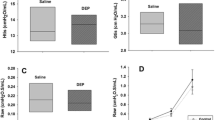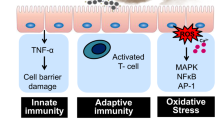Abstract
PM10, the commonly used indicator of respirable environmental suspended particulate matter with a mean aerodynamic diameter of less than 10 μm, is composed of organic or elemental carbon aggregates containing various metals, acid salts, organic pollutants (polyaromatic hydrocarbons, quinones, nitroaromatic hydrocarbons, etc.), and biological contaminants. In urban and industrial areas, fossil fuel combustion products (e.g., diesel exhaust particles and residual oil fly ash) are the main contributors to PM10. Epidemiological data show that air pollution particulates cause adverse pulmonary health effects, especially in individuals with preexisting lung diseases. A critical cell type that encounters particles after inhalation and that is affected in a number of respiratory diseases is the epithelial cell of the airway and alveoli. In vitro studies have shown that PM10 is responsible for the production and the release of inflammatory cytokines by the respiratory tract epithelium as well as for the activation of the transcription factor NFκB. As many of the adsorbed materials on the particle surface are direct oxidants (metals, quinones) and indirectly produce reactive oxygen species, it is hypothesized that oxidative stress may be a component of the mechanisms by which particles activate cytokine production and NFκB in epithelial cells.
Similar content being viewed by others
References
Baeza-Squiban A, Bonvallot V, Boland S, Marano F. Diesel exhaust particles increase NF-kB DNA-binding activity and c-fos proto-oncogene expression in human bronchial epithelial cells. Toxic In Vitro. 1999;13:817–22.
Baeuerle PA, Henkel T. Function and activation of NF-kappa B in the immune system. Annu Rev Immunol. 1994;12:141–79.
Bayram H, Devalia JL, Khair OA, et al. Comparison of ciliary activity and inflammatory mediator release from bronchial epithelial cells of nonatopic nonasthmatic subjects and atopic asthmatic patients and the effects of diesel exhaust particles in vitro. J Allergy Clin Immunol. 1998;102:771–82.
Bérubé KA, Jones TP, Williamson BJ. Electron microscopy of urban airborne particulate matter. Eur Microsc Anal. 1997;49:9–11.
Boland S, Baeza-Squiban A, Fournier T, et al. Diesel exhaust particles are taken up by human airway epithelial cells in vitro and alter cytokine expression. Am J Physiol. 1999;276:L604–13.
Boland S, Baeza-Squiban A, Bonvallot V, et al. Mechanisms of GM-CSF increase by diesel exhaust particles in human airway epithelial cells. Am J Physiol. 2000;278:L25-L32.
Carter JD, Ghio AJ, Samet JM, Devlin RB. Cytokine production by human airway epithelial cells after exposure to an air pollution particle is metal-dependent. Toxicol Appl Pharmacol. 1997;146:180–8.
Churg A. The uptake of mineral particles by pulmonary epithelial cells. Am J Respir Crit Care Med. 1996;154:1124–40.
Diaz-Sanchez D, Dotson AR, Takenaka H, Saxon A. Diesel exhaust particles induce local IgE production in vivo and alter the pattern of IgE messenger RNA isoforms. J Clin Invest. 1994;94:1417–25.
Diaz-Sanchez D, Tsien A, Casillas A, Dotson AR, Saxon A. Enhanced nasal cytokine production in human beings after in vivo challenge with diesel exhaust particles. J Allergy Clin Immunol. 1996;98:114–23.
Diaz-Sanchez D, Tsien A, Fleming J, Saxon A. Combined diesel exhaust particulate and ragweed allergen challenge markedly enhances human in vivo nasal ragweed-specific IgE and skews cytokine production to a T helper cell 2-type pattern. J Immunol. 1997;158:2406–13.
Dockery DW, Pope CA. Acute respiratory effects of particulate air pollution. Annu Rev Public Health. 1994;15:107–32.
Dreher KL, Jaskot RH, Lehman JR, et al. Soluble transition metals mediate residual oil fly ash induced acute lung injury. J Toxicol Environ Health. 1997;50:285–305.
Gilmour PS, Brown DM, Beswick PH, MacNee W, Rahman I, Donaldson K. Free radical activity of industrial fibers: role of iron in oxidative stress and activation of transcription factors. Environ Health Perspect. 1997;105:1313–17.
Jany B, Betz R, Schreck R. Activation of the transcription factor NF-kappaB in human tracheobronchial epithelial cells by inflammatory stimuli. Eur Respir J. 1995;8:387–91.
Jimenez LA, Thomson J, Brown D, et al. PM10 particles activate NF-kB in alveolar epithelial cells. Am J Respir Crit Care Med. 1999;159:A27.
Kennedy T, Ghio AJ, Reed W, et al. Copper-dependent inflammation and nuclear factor-kappaB activation by particulate air pollution. Am J Respir Cell Mol Biol. 1998;19:366–78.
Martin L, Krunkosky TM, Dye JA, et al. The role of reactive oxygen and nitrogen species in the response of airway epithelium to particulates. Environ Health Perspect. 1997;105:1301–7.
May WE, Benner BA, Wise SA, Schuetzle D, Lewtas J. Standard reference materials for chemical and biological studies of complex environmental samples. Mutat Res. 1992;276:11–22.
Nachtman JP. Superoxide generation by 1-nitropyrene in rat lung microsomes. Res Commun Chem Pathol Pharmacol. 1986;51:73–80.
Ohtoshi T, Takizawa H, Okazaki H, et al. Diesel exhaust particles stimulate human airway epithelial cells to produce cytokines relevant to airway inflammation in vitro. J Allergy Clin Immunol. 1998;101:778–85.
Quay JL, Reed W, Samet J, Devlin RB. Air pollution particles induce IL-6 gene expression in human airway epithelial cells via NF-kappaB activation. Am J Respir Cell Mol Biol. 1998;19:98–106.
Salvi S, Blomberg A, Rudell B, et al. Acute inflammatory responses in the airways and peripheral blood after short-term exposure to diesel exhaust in healthy human volunteers. Am J Respir Crit Care Med. 1999;159:702–9.
Samet JM, Stonehuerner J, Reed W, et al. Disruption of protein tyrosine phosphate homeostasis in bronchial epithelial cells exposed to oil fly ash. Am J Physiol. 1997;273:L426–32.
Steerenberg PA, Zonnenberg JAJ, Dormans JAMA, et al. Diesel exhaust particles induced release of interleukin 6 and 8 by (primed) human bronchial epithelial cells (BEAS 2B) in vitro. Exp Lung Res. 1998;24:85–100.
Takizawa H. Airway epithelial cells as regulators of airway inflammation (review). Int J Mol Med. 1998;1:367–78.
Takizawa H, Ohtoshi T, Kawasaki S, et al. Diesel exhaust particles induce NF-kappaB activation in human bronchial epithelial cells in vitro: importance in cytokine transcription. J Immunol. 1999;162:4705–11.
Woolcock AJ, Chest JK. Evidence for the increase in asthma world-wide. In: The rising trends of asthma. Chichester, UK: Wiley, Ciba Foundation, 1997;122–34.
Zandi E, Rothwarf DM, Delhase M, Hayakawa M, Karin M. The IκB kinase complex (IKK) contains two kinase subunits, IKKα and IKKβ, necessary for IκB phosphorylation and NF-κB activation. Cell 1997;91:243–52.
Author information
Authors and Affiliations
Rights and permissions
About this article
Cite this article
Baeza-Squiban, A., Bonvallot, V., Boland, S. et al. Airborne particles evoke an inflammatory response in human airway epithelium. Activation of transcription factors. Cell Biol Toxicol 15, 375–380 (1999). https://doi.org/10.1023/A:1007653900063
Issue Date:
DOI: https://doi.org/10.1023/A:1007653900063




